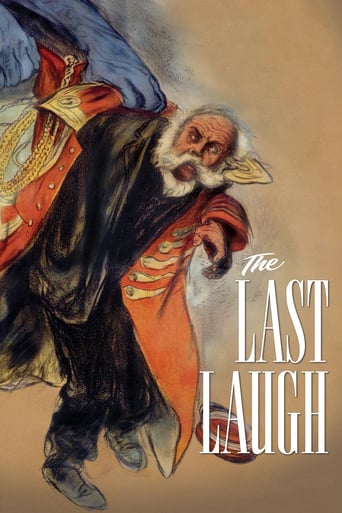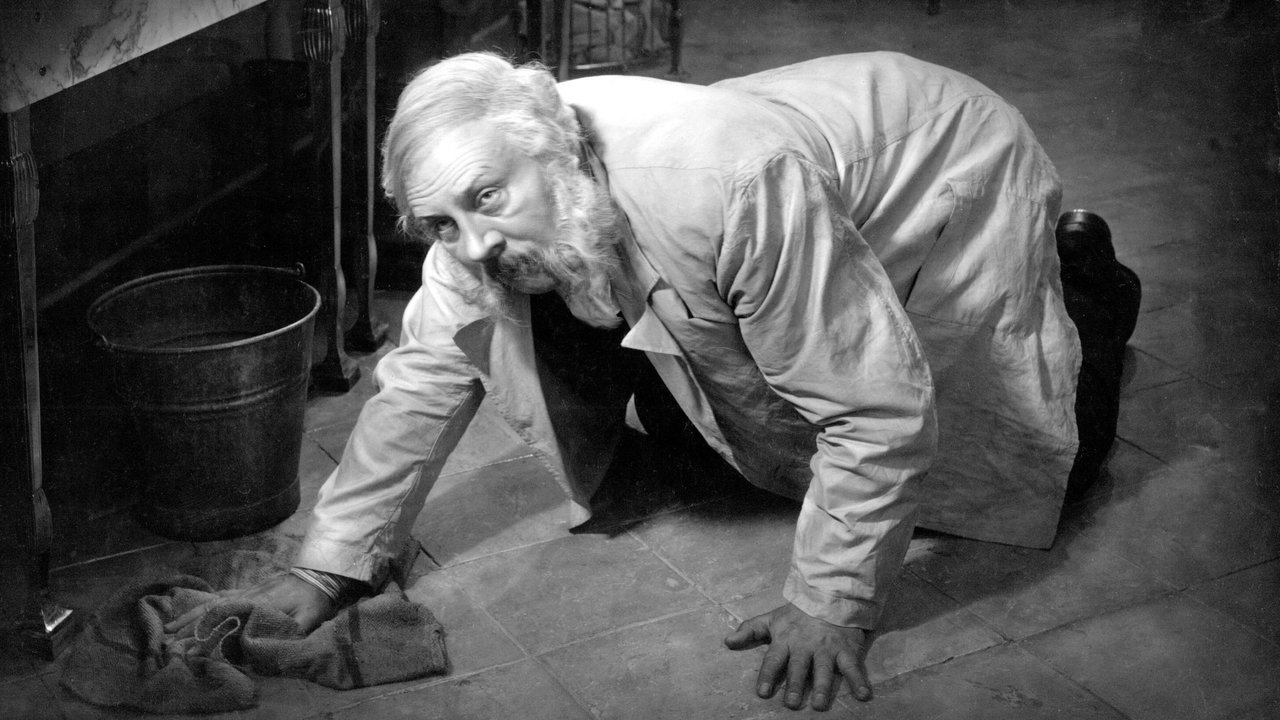Claudio Carvalho
Emil Jannings is the doorman of the elegant Atlantic Hotel. He is proud of his uniform and function, and respected by his community. When he reaches the old age, he has difficulties to carry trucks and suitcases. The hotel manager decides to change his function to washroom attendant. This apparently simple action is enough to destroy him as a human being. He loses his self-respect and when his neighbor finds that he is janitor of the hotel, he loses the respect of his neighbors and friends. "Der letzte Mann", a.k.a. "The Last Laugh", is another masterpiece directed by F.W. Murnau. It is an authentic study of the vanity and cruelty of mankind. The gossip and lack of respect to the elders is also shown in this fantastic film. The performance of the great Emil Janning is top-notch and the plot is based on his character and corporal expressions. The talent of Murnau is impressive, since he changes the heartbreaking narrative and turns into a comedy, with the doorman receiving the inheritance of an America millionaire and becoming "the last laugh" of the title of the movie. My vote is ten.Title (Brazil): "A Última Gargalhada" ("The Last Laugh")
poe426
Emil Jannings, who played Mephisto to the proverbial hilt in Murnau's FAUST, scores yet again as Herr Doormann in THE LAST LAUGH. He manages to convey a sincere, touching dignity that his ultimate fall from grace makes all the more poignant. (At one point, seeing a little girl being bullied by other Dead End kids, he sends them on their way and graciously gives her a small bag of candy. No sooner has he exited the shot than the Dead Enders are back, descending on her with her little bag of goodies like a pack of vultures. It's this kind of small, sensitive touch throughout that helps make his final fate all the more telling.) But that's not all: Murnau's mobile movie-making technique was light years ahead of what anyone else was doing at the time, and it's this improvised improvement that helps make THE LAST LAUGH one of the greatest silents ever lensed. With that single stroke of brilliance, THE LAST LAUGH advances the art of cinematography. (Much has been made of hand-held rigs with gyroscopic mounts, but one need only see THE LAST LAUGH to realize that there's more than one way to skin a cat.) The one glaring fault is, of course, the deus ex machina- the epilogue that Murnau was instructed to tack on to the end (which I didn't know- but had suspected- until I read about it here on the IMDb). More than "improbable," it's downright stupid, and singlehandedly undercuts everything that has come before it (in terms of story). Even so, THE LAST LAUGH is still must-see film-making for anyone who takes film-making seriously. It's absolutely brilliant.
funkyfry
From the very first shots of this movie, my friend and I were just in awe of the way Murnau uses the camera to set up his situation. There's an intimacy to it, he brings us close to the characters. Also the way he uses the angles and straight lines of the windows, doors and buildings to frame his shots impresses us immediately with the dehumanizing nature of the city much as it did in his Oscar Winning American film "Sunrise: A Song of Two Humans." As if the impressive direction and photography weren't enough to distinguish this as one of the most impressive films I've seen from the early 20s, the whole affair is anchored by a brilliant performance from Emil Jannings. He plays a man who is retired from his position as a hotel doorman and demoted to the washroom, which leads to a sort of nervous breakdown imaginatively filmed and a fetishistic attachment to the uniform of his former office.This isn't a plot heavy film or a drama heavy film, basically it's a character study. It's remarkable for the fact that there are no dialog title cards, and only 2 or 3 informational title cards relating to various events and anchored to specific informational devices interior to the film (e.g. we see the boss' letter telling him of his demotion). The quality of the acting not only from Jannings but from the entire cast (perhaps with the exception of a broadly played gossip woman) we see very natural performances that you often don't in silent films.Of the 3 films I've seen by Murnau, this film impressed me the most. It doesn't have the melodramatic elements that make "Sunrise" a bit more predictable, and it doesn't have the languid pace that slows "Nosferatu" for me. It reminds me in some ways of the films I've seen from the 30s by Jean Renoir -- there's this fantastic way that the camera follow the actors around on the streets, pulling ahead of them momentarily and then allowing the main actor to zip through the frame while it focuses on incidental details. I'm thinking specifically of the scene where Jannings escapes after stealing back the uniform, but there are several scenes along these lines.Essentially I saw this film as a message of hope, interestingly couched with an explanation from the film-makers that "in reality" it would not have ended happily. It's too easy to see this card, one of as I said only 2 or 3 in the entire film and the only one that's not tied to a specific device, as Murnau's way of eating his cake and having it too. Is there a touch of the ending from this movie, with the two former bums riding off together, that comes to mind when you see Wilder's "Some Like It Hot"? Or has this been filtered by way of Mssrs. Lubitsch and Renoir et al? Either way I would describe the movie overall as purely cinematic, miles and miles beyond normal film-making techniques and taste of the early 20s and even arguably of today.
Thorkell A Ottarsson
The camera work and the sets in this film where so breathtaking and powerful that they changed the film language forever. It is in many ways the Citizen Kane of its time.It was so revolutionary that Hollywood (Fox) tried desperately to get Murnau to work for them and teach them how to do all these things (which he did some years later). The main revolutionary thing was the fluidity of the camera (or the unchanged camera, as it was called). There was no steady cam at this time, but still they managed to strap the camera to the body of the cameraman without getting a shaky pictures.The set is just amazing. It is difficult to believe that this is not a real city. All the special effects help also to make this believable (special effects that are still today astonishing and believable).The makeup is also great. Emil Jannings was only 40 years old when he made this film but he really looks like an old man (and acts like one too).But the greatest thing about this film is how much Murnau manages to say with out the help of inter titles. This is visual storytelling at it's best.Murnau had come a long way from Nosferatu but he still had a long way to go and a lot to teach us before his untimely death. The Last Laugh is not only one of his best films, it is also most likely his most important one, and one of the most important films in film history.



 AD
AD




